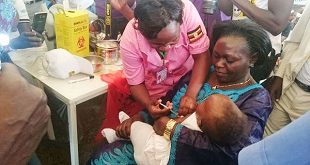By that time, both the original patient and the driver of the motorbike who took him to the hospital, his brother, had died, according to Alima, a medical humanitarian organization working in the country.
The body of the original patient was taken back to his village for burial, and a follow-up ministry health team later identified six others who had fallen ill in the same village, according to officials at the Centers for Disease Control and Prevention, who are participating in coordination meetings but not yet been asked to provide epidemiological or laboratory support.
The health workers who treated the patients without protective gear are now also in grave danger of contracting the disease. Because the confirmed case traveled across Bas-Uélé, contact tracers will now have a more difficult task ahead of them, seeking and isolating possible Ebola cases in at least two disparate villages, according to Alima.
But health personnel dispatched to the region are hopeful that the outbreak will mirror previous, limited Ebola outbreaks in the country.
“There will be more cases, but it is more likely to look like other outbreaks in Congo, a smaller outbreak, ending faster,” said Susan Shepherd, Alima’s medical coordinator.
“It’s very isolated there,” said Silvain Yuma, chief of staff at the ministry of health.
One of those previous outbreaks was in the neighboring province of Haut-Uélé in 2012. There were 41 cases there and 18 deaths. The outbreak lasted for around four months.
DRC officials said the confirmed infection involved the Zaire strain, which was the most common one present during the 2014-15 outbreak. Scientists are in the late stages of developing a vaccine that targets that specific strain, and it is likely to be made available for use if the outbreak is found to be large enough to warrant such an intervention. The vaccine has not yet been approved by the U.S. Food and Drug Administration, but could be made available under an emergency use authorisation.
An agreement between Gavi, the Vaccine Alliance, and Merck, the developer of the vaccine, ensures that the vaccine is available in case of an outbreak, said Gavi’s chief executive, Seth Berkley, in a statement. “The fact that this is a country that has experience dealing with Ebola should give us hope that we won’t see a pandemic on the scale of the 2014 outbreak that hit West Africa,” he said.
The WHO and others will determine if and when deployment of vaccine into this outbreak is warranted. The WHO has previously said it was preparing to make an initial 300,000 doses of the vaccine available in case of an outbreak.
Yokouidé Allarangar, WHO representative in the DRC, said in a statement on May 12 that the first teams of specialists — including epidemiologists, biologists, and experts in the areas of social mobilization, risk communication and community engagement and also personnel specializing in water, hygiene and sanitation — were travelling to reach the affected area, which is about 800 miles from the capital Kinshasa.
Allarangar also appealed to other medical organisations to join in the response. A number of them, including Médecins Sans Frontières (Doctors Without Borders) and the United Nations Children’s Fund (UNICEF), have already offered their support.
The CDC, which established an office in the DRC in 2002, also has staff in the country working on a vaccine trial for monkeypox, a rare viral disease that is endemic in the DRC.
PATH, a Seattle-based health technology nonprofit, has been working with the health ministry to establish an Emergency Operations Center and geospatial mapping capabilities, a spokeswoman said. The outbreak is in a remote location and there is a lack of high-quality maps.
Unlike the countries in West Africa that were hardest hit by the 2014 Ebola epidemic, the DRC has had much more experience with the disease, including seven previous Ebola outbreaks since the virus was first discovered in the country in 1976.
The DRC was not one of the main three African countries hit by the 2014 epidemic, but the toll on the country was significant. The WHO confirmed 66 cases with 49 deaths. Worldwide, more than 28,600 people were infected and 11,300 died. The countries at the epicenter of the crisis — Guinea, Sierra Leone and Liberia — have all been Ebola-free since at least June of last year.
That outbreak was a wake-up call for global public health officials whose response has been widely criticised for being slow and disorganised. Many new measures have been set up to respond to future epidemics, such as better communication systems and quarantine procedures, but there’s still much more that is needed.
A review on the world’s pandemic readiness published in the New England Journal of Medicine last year said that an investment of at least $4.5 billion is needed each year for improving detection and response tools. The paper, funded by philanthropic and academic groups, including the Paul G. Allen Family Foundation, Ford Foundation and the Bill & Melinda Gates Foundation, had a sobering prediction: that at least one pandemic event will almost certainly occur in the next 100 years and that there is a 20 percent chance of four or more.
****
Source: The Washington Post
 The Independent Uganda: You get the Truth we Pay the Price
The Independent Uganda: You get the Truth we Pay the Price



Please let WHO ask for support from
Uganda Since Uganda had experiences in managing such outbreaks
Great post! Have nice day ! 🙂 nwklb